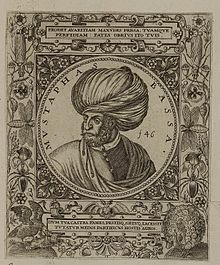Lala Kara Mustafa Pascha


Lala Kara Mustafa Pascha oder auch Lala Mustafa Pascha (* um 1500; † 7. August 1580) war ein osmanischer General und für kurze Zeit Großwesir. Sein Ehrentitel Lala bedeutet „Tutor eines Prinzen“. ein Lala wurde einem Prinzen als Berater bei der Verwaltung seiner Provinz zugeteilt. Lala Mustafa Pascha war zuerst der Lala Prinz Bayezids, dann Prinz Selims, des späteren Sultan Selims II.
Lala Mustafa war bis zum Beylerbey von Damaskus aufgestiegen und dann Fünfter Wesir geworden, ehe er 1565 die osmanischen Landtruppen bei der Belagerung von Malta befehligte und danach auch die Landtruppen, die 1570–71 das bis dahin venezianische Zypern eroberten.
Vom 28. April bis zum 7. August 1580 war er kurzzeitig Großwesir des Reiches (siehe Liste der Großwesire des Osmanischen Reiches). Mustafa war für seine Grausamkeit gegenüber besiegten Gegnern bekannt, wie seine Behandlung von Marcantonio Bragadin, dem venezianischen Verteidiger von Famagusta, anschaulich bewies.
Die Lala-Mustafa-Pascha-Moschee in Famagusta wurde nach ihm benannt.
Literatur
- Uberto Foglietta: The Sieges of Nicosia and Famagusta. Waterlow & Sons, London 1903.
- Edward Hamilton Currey: Sea-Wolves of the Mediterranean. London 1910.
- Ernle Bradford: The Great Siege. Malta 1565. London 1961 (deutsch: Der Schild Europas, Universitas-Verlag, 1978; Ullstein, München 1979, ISBN 3-548-34912-9).
- Josef Matuz: Mustafa Pascha, Lala. In: Biographisches Lexikon zur Geschichte Südosteuropas. Bd. 3. München 1979, S. 278 f.
- Tim Pickles: Malta 1565. Last Battle of the Crusades (= Osprey Campaign Series 50). Osprey Publishing, 1998.
- Stephen C. Spiteri: The Great Siege. Knights vs. Turks, 1565. Selbstverlag, Malta 2005.
| Vorgänger | Amt | Nachfolger |
|---|---|---|
| Semiz Ahmed Pascha | Großwesir des Osmanischen Reiches 8. April 1580–7. August 1580 | Koca Sinan Pascha |
| Personendaten | |
|---|---|
| NAME | Lala Kara Mustafa Pascha |
| ALTERNATIVNAMEN | Lala Mustafa Pascha |
| KURZBESCHREIBUNG | osmanischer General und für kurze Zeit Großwesir |
| GEBURTSDATUM | um 1500 |
| STERBEDATUM | 7. August 1580 |
Auf dieser Seite verwendete Medien
Grafik aus dem Klebeband Nr. 1 der Fürstlich Waldeckschen Hofbibliothek Arolsen
Illustration aus: Georg Greblinger: Wahre Abbildungen der Türckischen Kayser vnd Persischen Fürsten / so wol auch anderer Helden und Heldinnen von dem Osman / biß auf den andern Mahomet. Johann Ammon, Frankfurt 1648
Motiv: "Mustafa Bassa" (Lala Mustafa Paşa)Autor/Urheber: Internet Archive Book Images, Lizenz: No restrictions
Tomb of Lala Mustapha, Famagusta
Identifier: myexperiencesofc00stew (find matches)
Title: My experiences of Cyprus; being an account of the people, mediæval cities and castles, antiquities and history of the island of Cyprus: to which is added a chapter on the present economic and political problems which affect the island as a dependency of the British empire
Year: 1908 (1900s)
Authors: Stewart, Basil, 1880-
Subjects: Cyprus -- Description and travel Great Britain -- Colonies Cyprus
Publisher: London : G. Routledge New York, E.P. Dutton
Contributing Library: University of California Libraries
Digitizing Sponsor: MSN
View Book Page: Book Viewer
About This Book: Catalog Entry
View All Images: All Images From Book
Click here to view book online to see this illustration in context in a browseable online version of this book.
Text Appearing Before Image:
s 57 My Experiences of the Island of Cyprus. may probably be due to some repairs made by the Turks after the bombardment of 1571. The author of a Winters Pilgrimage, m speaking of Famagusta, expresses some fear as to the fate of the sea wall facing the harbour, in connection with a threatened act of vandalism on the part of the authorities in throwing down this wall in order that the stone and area thus formed may be used for purposes of the railway from Famagusta to Nicosia. I am glad to say no such act of unjustifiable vandalism has been committed, and I can reassure his readers on that point. Three openings have been made in this wall to give access to the quay wall of the harbour, which have in no way detracted from its appearance. In the construction of the railway no stoneof antiquarian interest was allowed to be disturbed in any way, and any stones removed from the wall by the harbour authorities to facilitate access by the trains bringing material for the construction of the harbour from the 58
Text Appearing After Image:
Famagusta and Salamis. quarries outside, were carefully marked and replaced in their original position. The chief glory of Famagusta is the famous siege by the Turks from 1570 to 1571, about eleven months. Its defence by the Venetians was one of the most gallant recorded in history, and they finally succumbed, not to the battering of the Turk, but to hunger. The hero of the defence was Mark Antonio Bragadino; Mustafa was the Turkish general who conducted the siege, and he lies buried in a large tomb just outside the walls of Famagusta. Braogdino negotiated surrender on condition that the remaining defenders were to be given their lives and possessions, and safe conduct to Crete. After peace was signed, Bragadino, accompanied by his captains and bodyguard, unarmed, paid a visit to Mustafa in his tent, who received them courteously, and praised them for their gallant defence. Then, as they were retiring, Mustafa raised a question as to the Turkish prisoners taken during the 59 My Experiences of the I
Note About Images

